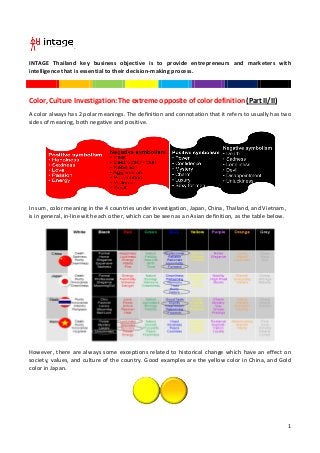
121007 color, culture investigation in vietnam, thailand, japan & china by intage thailand (2)
- 1. ` INTAGE Thailand key business objective is to provide entrepreneurs and marketers with intelligence that is essential to their decision-making process. Color, Culture Investigation: The extreme opposite of color definition (Part II/II) A color always has 2 polar meanings. The definition and connotation that it refers to usually has two sides of meaning, both negative and positive. In sum, color meaning in the 4 countries under investigation, Japan, China, Thailand, and Vietnam, is in general, in-line with each other, which can be seen as an Asian definition, as the table below. However, there are always some exceptions related to historical change which have an effect on society, values, and culture of the country. Good examples are the yellow color in China, and Gold color in Japan. 1
- 2. Yellow is not popular in China. No brand in China uses yellow as its colour cue, because yellow is the color of the Emperor. Unlike Japanese, Thai, and Vietnamese, yellow is still popular in these countries as it refers to brightness, hope, a morning sun symbolizing a fresh start. Gold is not popular in Japan. There is an expression in Japanese language relating to gold color: Narikin (成り金). It is used to refer to the newly rich people, or those who like to show-off their richness, which is against the genetic value of the Japanese people who prefer modesty and humbleness. On the contrary, Chinese, Thai and Vietnamese like gold as it symbolizes extravagance and prosperity. Significance of Color as a Buying Criterion 1. Chinese give importance to color for product categories that correspond to their personal image and identity. (ME & MY IMAGE) For Chinese, color is important when it comes to products that are attached to them, which respond to their need as well as project their image and personality. I. 58% give first priority to the color of their mobile phone. Popular colors are black, white, and silver, respectively. II. Secondly, 54% goes to car. Popular colors are black, silver, and red, respectively. III. Computer/notebook is at 48%. Popular colors are black, white, and silver, respectively. IV. The categories which color has least importance in purchasing decision are supplement food, house roof, and house exterior wall, at 15%, 21%, and 23%, respectively. 2
- 3. 2. Japanese give importance to color for product categories that correspond to their identity and usage. (ME & MY USAGE) For Japanese, color is important for products that are attached to them in order to respond to their daily use; that is, mobile phone, car, and house exterior wall. I. 40% gives highest importance to mobile phone. Popular colors are silver, white, and black, respectively. II. Next is car, at 28%. Popular colors are silver, white and black, respectively. III. House exterior wall is at 27%. Popular colors are cream, white and light yellow respectively. IV. The categories which color has least importance in purchasing decision are washing machine, supplement food, at 10% and 6%, respectively. 3. Thai people give importance to color for product categories that correspond to their identity, family image and status. (ME & MY FAMILY STATUS) For Thai people, color is important for products that reflects their identity, especially image and status of their family as perceived by others. The products are car, motorcycle, and house exterior wall. I. 85% of Thai people give highest importance to color of their car. Popular colors are black, silver, and white, respectively. II. Followed by the color of motorcycle. Popular colors are red, black, and white, respectively. III. Then, house exterior wall at 51%. Popular colors are white, cream, and light blue, respectively. IV. The categories which color has least importance in purchasing decision are supplement food and fragrance bottle, at 18% and 15% respectively. 3
- 4. 4. Vietnamese give importance to color for categories that correspond their identity, family image and status (ME & MY FAMILY STATUS) For Vietnamese, color is important for products that reflects their identity, especially image and status of their family as perceived by others. The products are car, motorcycle, and house exterior wall. I. 70% give highest important to color of their car. Popular colors are black, white, and silver, respectively. II. Followed by house exterior wall at 63%. Popular colors are light blue, white, silver, and green, respectively. III. Next, motorcycle at 53%. Popular colors are black, red, and white, respectively. IV. The categories which color has least importance in purchasing decision are television and washing machine at the equal 28%. What is interesting among Vietnamese is the increasing trend of choosing green color for the exterior house wall and house roof. This is because the green color can symbolically bring nature closer to them. The study restates two major issues that marketers should pay attention to: 1. Insightful understanding of consumer behaviour and need. Behaviour and need of consumers often comes from genetic value, norm, and the desire to express their self identity. 2. “Certainty is uncertain.” Popularity and beliefs can change over time, according to the context of each country and culture. Therefore, 'updated' consumer data is the most vital weapons for all marketers. 4
- 5. The above research was conducted by INTAGE Academy among the 4 offices of INTAGE Group in Japan, China, Thailand, and Vietnam. INTAGE Academy is the intelligence hub of INTAGE, the Intelligence Provider in Asia. For more information, please contact: INTAGE Academy INTAGE (Thailand) Co., Ltd. Tel. 02-6329945 Email: intage_academy@th.intage.com 5
